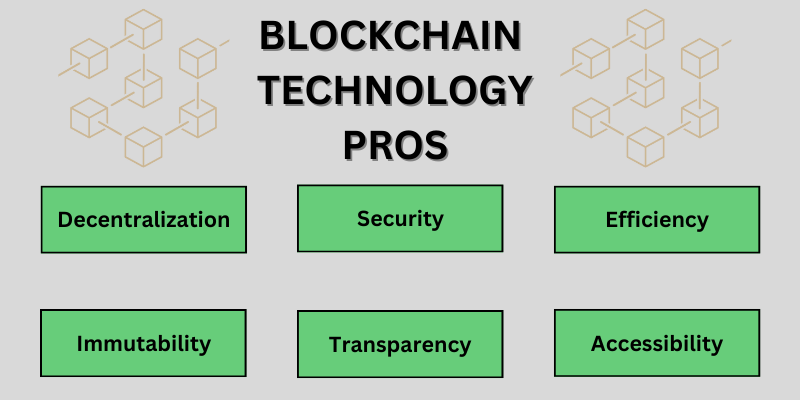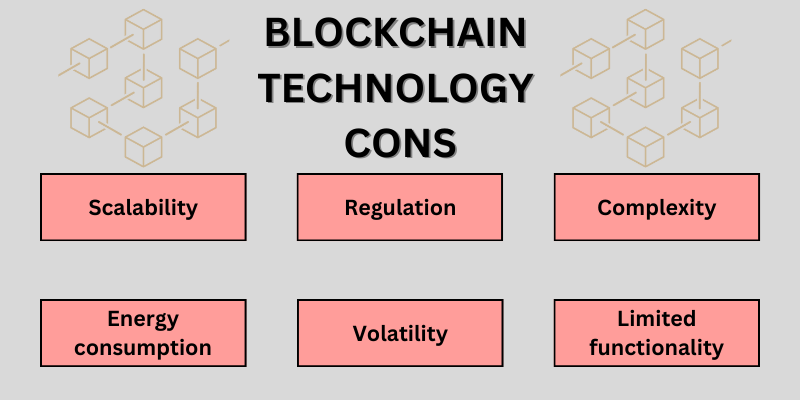Blockchain technology has become very popular recently and can challenge many industries. In this article, we highlight the pros and cons of blockchain technology and explain what blockchain technology is.
Blockchain Technology Pros
- Decentralization: Blockchain eliminates the need for a central authority, empowering individuals and reducing reliance on trusted third parties. This fosters transparency and trust and reduces the risk of fraud or manipulation.
- Immutability: Once data is added to a blockchain, it cannot be altered or deleted. This ensures the integrity and authenticity of information, creating a reliable audit trail.
- Security: Cryptographic algorithms and distributed ledger technology make blockchain highly resistant to cyberattacks and data breaches.
- Transparency: All transactions on a blockchain are visible to participants, promoting accountability and reducing opportunities for corruption.
- Efficiency: Automating processes and eliminating intermediaries can streamline transactions and save time and cost.
- Accessibility: Anyone with an internet connection can participate in blockchain networks, promoting financial inclusion and global reach.

Blockchain Technology Cons
- Scalability: Current blockchain technology can struggle to handle large volumes of transactions, potentially hindering wider adoption.
- Energy consumption: Proof-of-work consensus mechanisms used in some blockchains require significant computing power, raising concerns about environmental impact.
- Regulation: The lack of clear regulations surrounding blockchain creates uncertainty and can hinder innovation.
- Volatility: Cryptocurrencies associated with some blockchains experience high price fluctuations, posing risks for investors and businesses.
- Complexity: Understanding and implementing blockchain technology requires technical expertise, which can be a barrier for some users.
- Limited functionality: While evolving rapidly, blockchain technology is still in its early stages and may not offer all the functionalities needed for complex applications.

It’s important to remember that blockchain technology is not a one-size-fits-all solution. Carefully evaluating its pros and cons in the context of specific use cases is crucial before adopting it.
Key Facts about Blockchain and Crypto
Blockchain technology and cryptocurrency are terms often used interchangeably, but they differ. Here’s a breakdown of the key facts about each:
Blockchain Technology
A distributed ledger technology that stores data across a network of computers rather than a single server. This makes it highly secure and transparent.
Key features:
- Decentralization: No single entity controls the network, making it resistant to censorship and manipulation.
- Security: Cryptographic techniques and distributed consensus mechanisms ensure data integrity and prevent unauthorized access.
- Transparency: All participants can access the ledger, fostering trust and accountability.
- Immutability: Once recorded, data cannot be altered or deleted, ensuring the accuracy of the historical record.
Cryptocurrency
A digital or virtual currency that uses cryptography for security. It operates independently of central banks and governments.
Key features:
- Decentralization: No central authority controls the issuance or management of the currency.
- Security: Cryptographic techniques secure transactions and protect against counterfeiting.
- Transparency: Transactions are recorded on a public blockchain, making them auditable and transparent.
- Volatility: Cryptocurrency prices can fluctuate significantly, making them a risky investment.
What is Blockchain and How Does it Work?
Blockchain is a complex and multifaceted technology, but here is a breakdown that goes beyond the basics:
Blockchain Explained:
- It’s a distributed ledger technology, meaning it stores data in a decentralized way across a network of computers rather than a single server.
- This distributed nature makes it highly secure and transparent. Records are tamper-proof, as any attempt to alter one block would require changing all subsequent blocks on all participating computers, which is nearly impossible due to the network’s size and complexity.
- Each transaction is grouped into a block containing details like timestamps, participants, and data. These blocks are linked chronologically in a chain, creating an immutable record.
Here’s a breakdown of its core concepts:
Building Blocks:
- Blocks: Each transaction is grouped into a “block,” containing details like date, amount, and participants.
- Hashes: Each block has a unique fingerprint called a “hash,” linked to the previous block’s hash, forming a chain.
- Chain: This connected chain of blocks creates an immutable record, meaning information can’t be altered without changing every subsequent block, making it highly tamper-proof.
Security and Transparency:
- Distributed Network: The ledger isn’t stored in one place but across a network of computers, all verifying each transaction. This decentralization eliminates single points of failure and manipulation.
- Cryptographic Proof: Complex math problems, called “proof of work,” secure the network. Computers compete to solve them, earning rewards (e.g., cryptocurrency) while validating transactions.
Beyond Cryptocurrency:
While popularized by Bitcoin, blockchain has potential beyond just digital currencies. Its secure and transparent nature can be applied to various industries:
- Supply Chain Management: Tracking goods and materials from origin to destination, ensuring authenticity, and preventing fraud.
- Voting Systems: Secure and auditable voting processes, reducing manipulation and increasing trust.
- Identity Management: Secure and decentralized storage of personal data, empowering individuals with control over their information.
What is Cryptocurrency and How Does It Work?
Decentralization
Cryptocurrency is a digital or virtual form of currency that uses cryptographic techniques for secure financial transactions and to control the creation of new units. Here’s a detailed explanation of how cryptocurrency works:
Cryptocurrencies operate on a decentralized network of computers known as nodes. Unlike traditional currencies, no central authority or government is regulating these currencies.
Blockchain Technology
The majority of cryptocurrencies utilize blockchain technology. A blockchain is a distributed ledger that records all transactions across a network.
It consists of a blockchain, each containing a list of transactions. This decentralized and transparent system ensures the integrity of the currency.
Cryptography
Cryptocurrencies use cryptographic techniques to secure transactions and control the creation of new units. Public and private keys are generated for each user, ensuring secure ownership and transfer of assets.
Mining and Consensus Mechanisms
Cryptocurrencies often employ a consensus mechanism, such as Proof of Work (PoW) or Proof of Stake (PoS), to validate and confirm transactions.
Miners or validators solve complex mathematical problems to add new blocks to the blockchain, ensuring the ledger’s integrity.
Peer-to-Peer Transactions
Cryptocurrencies enable direct peer-to-peer transactions without the need for intermediaries like banks. Users can transfer funds directly to one another, promoting faster and potentially more cost-effective transactions.
Wallets
Users store their cryptocurrencies in crypto wallets. These wallets can be hardware-based, software-based, or even paper wallets. Wallets store the user’s private keys, allowing them to access and manage their cryptocurrency holdings.
Limited Supply
Many cryptocurrencies have a capped supply, such as Bitcoin’s limit of 21 million coins. This scarcity can influence value and is often designed to mimic precious metals like gold.
Smart Contracts (in some cases)
Ethereum and other blockchain platforms support smart contracts – self-executing contracts with the terms of the agreement directly written into code. This enables programmable and automated contracts without intermediaries.
Anonymity and Privacy
While transactions are recorded on the blockchain and are transparent, users are generally identified by cryptographic addresses rather than personal information, providing privacy.
Global Accessibility
Cryptocurrencies can be accessed and used globally, allowing individuals in different parts of the world to participate in the financial system without traditional banking infrastructure.
Cryptocurrency works through a decentralized network, blockchain technology, cryptographic security, consensus mechanisms, and peer-to-peer transactions.
It provides a secure, transparent, and potentially more efficient alternative to traditional currencies and financial systems.
Summary – Blockchain Technology Pros and Cons
Blockchain Technology is a decentralized ledger system that secures and records transactions across a network of computers using cryptographic techniques.
The pros of blockchain technology include decentralization, security, transparency, efficiency through smart contracts, and global accessibility.
However, disadvantages of blockchain technology, like scalability, energy consumption (in some cases), regulatory uncertainty, irreversibility of transactions, and a lack of universal standards, may impact its widespread adoption.
FAQ
What are the advantages of blockchain technology❓
Blockchain technology offers decentralization, immutability, security, transparency, efficiency, and accessibility. It empowers individuals, reduces fraud, and provides a reliable audit trail.
What are the disadvantages of blockchain technology❓
The disadvantages of blockchain technology are scalability issues, energy consumption concerns, regulatory uncertainty, price volatility, complexity, and limited functionality.
How does blockchain ensure security❓
Blockchain uses cryptography and a distributed ledger to create a secure and unchangeable system, ensuring the integrity of stored data.
What does decentralization mean in blockchain❓
Decentralization removes the need for a central authority, promoting transparency and trust and reducing the risk of fraud.
Where else can blockchain be used apart from cryptocurrencies❓
Due to its secure and universal nature, blockchain can be used in various industries, such as supply chain, voting, and identity management.